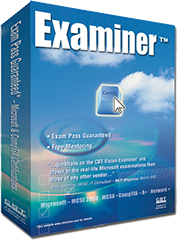Examiner - N10-003
 |
Examiner™ for CompTIA Exam N10-003: |
* CompTIA may incorporate newer testing technologies or content into a given exam at any time. It may change the characteristics of its exams without prior notice.
The Network+ exam is a start or a steppingstone for many people in building the credentials they need for a successful IT career. These days it can count even more for other vendor's certifications like the Microsoft MCSA.
Officially CompTIA describes the typical Network + candidate as knowing the layers of the OSI model, being able to describe the features and functions of network components and having the skills to install, configure, and troubleshoot basic networking hardware peripherals and protocols. This level of competency can be gained from at least nine months networking experience.
More information can be found at the web site. The material your exam is going to test you on is divided into four main areas for your studying convenience:
Media & Topologies (20 % of the total exam)
This includes knowledge of star, bus, mesh, ring and wireless networking. You'll need to know that numbers like 802.2, 802.3 and 802.5 match up with names and initials like LLC, Ethernet and token ring. You should be able to identify and distinguish among hubs, switches, routers, bridges, gateways and CSU/DSUs. Recent additional requirements and emphases include familiarity with 802.11(wireless), and FDDI (Fiber Distributed Data Interface). Brand new material to master includes 1000BASE-T, 1000BASE-CX, 1000BASE-SX, 1000BASE-LX, 10 GBASE-SR, 10 GBASE-LR and 10 GBASE-ER. Do you known all the connectors for fiber optic media and cabling? You should.
Protocols & Standards (Reduced to 20 % of the total exam from 25%)
Whatever the percentages, you must be able to differentiate between network protocols like TCP/IP, IPX/SPX, NetBEUI and AppleTalk in terms of routing addressing schemes, interoperability and naming conventions. There is a special emphasis on the many aspects of TCP/IP. Additionally, Mac OS X Server questions are a real possibility. Also be familiar with the standards and practices that lurk behind these acronyms and identifiers: PPPoE, WPA, WEP, RDP, IPSec, L2TP and 802.1x. Be familiar with the details of IPv6 addressing.
Network Implementation (Increased 25 % of the total exam from 23%)
What can the various operating systems like UNIX/Linux, Netware, Windows and Mac OS X Server do for you or to you? When it comes to client support, interoperability, authentication, file and print services, application support and security you'd better find out. Then there's VLANs, network attached storage and fault tolerance too. Proxies, firewalls, remote connectivity and network security round out the remaining list of things to do to get a network implemented. Additionally, Mac OS X Server questions are a real possibility. New nuances emphasize secure communication mechanisms such as Secure FTP and SSH.
Network Support (Now 35 % of the total exam)
Once your network is up and running you'll need to support it. There will occasionally be trouble. You need to be able to troubleshoot TCP/IP using tools like tracert, ping arp, netstat, nbtstat, nslookup, ipconfig and its cousins ifconfig and winipcfg. You'll need to use your eyes, ears, brain and even a manual or two to set things right and keep things going. Additionally, Mac OS X Server questions are a real possibility. DNS tools such as nslookup and dig are also covered.
There is one thing that you can feel secure about: Examiner™ has everything you need to pass your exam.
Where are you going to start? How about trying 403 questions on networking and nothing but networking? We've got the questions. We've got the answers. We've got the explanations.
Examiner™ has everything you need to pass your exam.
